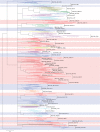Phylogeny of the plant receptor-like kinase (RLK) gene family and expression analysis of wheat RLK genes in response to biotic and abiotic stresses
- PMID: 37127571
- PMCID: PMC10152718
- DOI: 10.1186/s12864-023-09303-7
Phylogeny of the plant receptor-like kinase (RLK) gene family and expression analysis of wheat RLK genes in response to biotic and abiotic stresses
Abstract
Background: The receptor-like kinase (RLK) gene families in plants contains a large number of members. They are membrane proteins with an extracellular receptor domain and participate in biotic and abiotic stress responses.
Results: In this study, we identified RLKs in 15 representative plant genomes, including wheat, and classified them into 64 subfamilies by using four types of phylogenetic trees and HMM models. Conserved exon‒intron structures with conserved exon phases in the kinase domain were found in many RLK subfamilies from Physcomitrella patens to Triticum aestivum. Domain distributions of RLKs were also diagrammed. Collinearity events and tandem gene clusters suggested that polyploidization and tandem duplication events contributed to the member expansions of T. aestivum RLKs. Global expression pattern analysis was performed by using public transcriptome data. These analyses were involved in T. aestivum, Aegilops tauschii and Brachypodium distachyon RLKs under biotic and abiotic stresses. We also selected 9 RLKs to validate the transcriptome prediction by using qRT‒PCR under drought treatment and with Fusarium graminearum infection. The expression trends of these 9 wheat RLKs from public transcriptome data were consistent with the results of qRT‒PCR, indicating that they might be stress response genes under drought or F. graminearum treatments.
Conclusion: In this study, we identified, classified, evolved, and expressed RLKs in wheat and related plants. Thus, our results will provide insights into the evolutionary history and molecular mechanisms of wheat RLKs.
Keywords: Biotic and abiotic stresses; Collinearity events; Conserved exon–intron structures; Evolution; Expression patterns in wheat; Receptor-like kinase gene family.
© 2023. The Author(s).
Conflict of interest statement
The authors declare no competing interests.
Figures






References
MeSH terms
Substances
Grants and funding
- J18KA117/A Project of Shandong Province Higher Educational Science and Technology Program
- 2019NS080/the Science and Technology Development Plan of Tai 'an in 2019 (guidance plan)
- ZR2022QC129/Natural Science Foundation of Shandong Province
- 318052018/Doctoral research start-up funds from Liaocheng University
- 2021KF03/Open project of State Key Laboratory of Crop Biology in Shandong Agricultural University
LinkOut - more resources
Full Text Sources
Molecular Biology Databases

